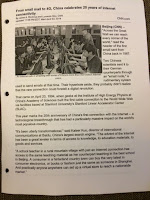Google Drive and Apps in the Classroom - Part 1: Google Forms
I am excited to launch a blog series about how to use Google Drive and Apps in the classroom!
This is the first of ten posts over the next two months. Although I have used Google Drive for personal use over the last several years, I have limited experience using it in class. The district I previously worked in used Microsoft Office 365, for teacher and student collaboration. The local district I moved into, have done a little bit of subbing for, and plan to work in within the next couple of years, uses Google Drive for teachers and students. Needless to say, I have some learning to do.This series is designed to aid my exploration of the potentials in the classroom, help me keep a record of them, and gain feedback from you all as I go.
One of the few ways I have previously used Google Drive in my classroom was using Google Forms. I used these in my reading intervention to gather survey data and to create online reading experiences to try to help transition students to our online form of state testing.
After using a Google Form earlier this summer, I noticed a new feature that did not exist when I originally used these a few years back. There is now a way to create Quizzes and Assessments! This is definitely something I hope to use in the future and am interested in keeping an eye on.
Here is a short tutorial showing all of the new features, enjoy!




